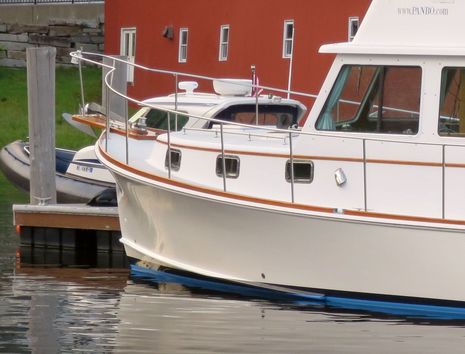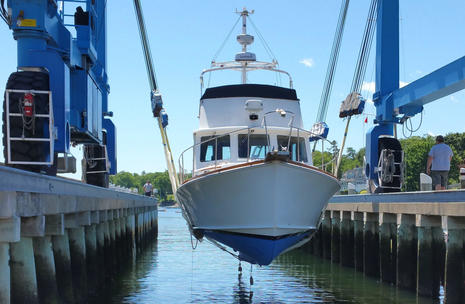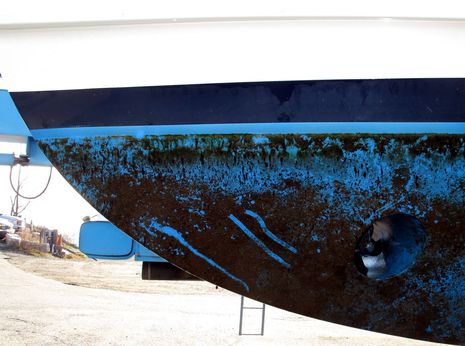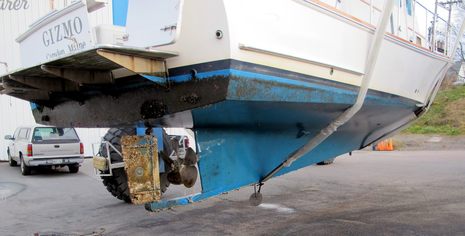Gizmo’s Ocean Armor topsides & Pettit Hydrocoat Eco bottom, the testing begins
 Check out the evening gleam on Gizmo’s flared bow. I think it’s impressive for a gelcoat surface that’s seen a lot of weather over 14 years and better yet, the pros who applied the “nano polymer wax replacement” were also impressed. There’s more detail on the new coating called Ocean Armor Pro Maxi All Gloss further along in this entry and also my experience with an initial application of Pettit HydroCoat Eco bottom paint, which seems like another winner so far…
Check out the evening gleam on Gizmo’s flared bow. I think it’s impressive for a gelcoat surface that’s seen a lot of weather over 14 years and better yet, the pros who applied the “nano polymer wax replacement” were also impressed. There’s more detail on the new coating called Ocean Armor Pro Maxi All Gloss further along in this entry and also my experience with an initial application of Pettit HydroCoat Eco bottom paint, which seems like another winner so far…
You may recall that I already conducted a three-year test of copper-free Interlux Pacifica Plus and it did pretty well. When Pettit claimed that their unique copper-free and water-based Hydrocoat Eco could do even better, I was of course interested but then got concerned that the remaining and still quite ablative Pacifica Plus would have to be removed. However, Pettit told me that any of their Hydrocoats can go over almost any other paint because the lack of normal solvents means that the old paint can’t get kicked off again with possible troublesome effects like bubbling. In fact, they said that if Gizmo’s new bottom coat wears off, the old Pacifica Plus will go back to work again. Wayfarer Marine painter Wes Ames did hit the old paint with a scrubby (old habits die hard), but the Hydrocoat Eco certainly went on without issues. Wes doesn’t look happy in this photo — who would when on your knees painting overhead? — but he did enjoy the lack of solvent fumes (and only masked up to avoid splatter on his face). Note how rudder, prop, and even transducers are all getting anti-fouling paint…
I failed to take photos this time around, but want you to know that I’d already sprayed the prop and rudder with Pettit’s “new” 1792 Prop Coat Barnacle Barrier. I’m qualifying “new” because Prop Coat is exactly the same as the 1792 Zinc Coat Barnacle Barrier that I’ve been using on at least the prop for years (May 2010 photo above). I’m glad for the slight name change, though, as I always worried a bit that it might cause some odd prop corrosion, even though it seemed to work pretty well. In fact, here’s a photo showing a 1792-coated prop after 18 months versus a rudder I only coated with very ablative Pacifica Plus that apparently went away quickly in the prop wash. At any rate, Pettit assured me that Prop Coat is fine for props and that it would last even longer with a top coat of Hydrocoat Eco, which is exactly what I hope to test for the next 18 months. (They also advised me to shake the 1792 spray cans beyond normal during the two-coat application to avoid the dimply wear pattern that had been my only real objection to the product.)
I got a further sense of Hydrocoat Eco by doing a quickie bottom coat on Gizmo’s summer tender. You can see that two long winters upside down in my yard had pretty much eliminated the Pacifica Plus I’d applied in May 2012, so I just washed the hull, taped and painted. I wasn’t racing and was sidetracked a few times, but the photo records show that only two hours elapsed between the scene above and below…
I barely even stirred the Hydrocoat Eco and I applied it with a 4 inch disposable brush. It doesn’t tend to separate, goes on very easily, covers well, dries fast, and doesn’t smell a bit. It was even easy to wash my hands and the brush, and then, per instructions, I poured a little water in the remaining half gallon so it won’t skim dry in storage. All told, about 1.5 gallons sufficed for a 10-foot tender and 37-foot powerboat with the latter getting an extra coat around the waterline. I also touched up a few spots where the white paint (great Epifanes Yacht Enamel) had chipped to the black gelcoat, but the yellowy scum marks that failed to wash off did succumb to a special gunk…
I learned about Davis FSR (Fiberglass Stain Remover) a year ago when dealing with the nasty and tenacious brown “moustache” that had accumulated on Gizmo’s bow while running the tannin-rich ICW. It worked extremely well and was even easy to apply with a rag from a dinghy, though good rubber gloves are highly recommended. While some CruisersForum commenters report good results with less expensive household products, I still had enough FSR to whiten the tender “good enough” for the summer. (Note the EasyBailer solar tender pump in the background, still in fine shape after four seasons.)
In retrospect, I wish the Wayfarer topsides crew had tried a little FSR on the tannin stains remaining near Gizmo’s waterline, because that was the only area where they felt obliged to use a compound with a heavier cut than the sample Ocean Armor Pro Maxi Finishing Compound, which otherwise “seemed to take away the oxidization quickly and gave a great substrate to the ‘wax’.” My service manager, Doug Woodbury, also reported that Pro Maxi polymer All Gloss sealer “went on very well and seems to bring a very nice sheen to the gelcoat surface.” I like how it looks, too, and 15.5 hours of labor to polish and “wax” Gizmo’s topsides seems reasonable, but perhaps the highest accolade was when Doug asked me to put him in touch with Ocean Armor, which is a brand-new contender in a field full of decent boat maintenance products. Meanwhile, there are many other surfaces on Gizmo that might benefit if I actually try the Pro Maxi line myself, and I’ll report here when I do.
So Gizmo isn’t fully commissioned yet, but she’s at least looking good up to the toe rail. The schedule is long though — like 18 months in the water if all goes well — and she will be flying flags before the weekend is over. Here’s wishing all U.S. readers a great and boaty Memorial Day.






















Ben, we certainly hope you have better luck with the Eco than we are having with the standard Hydrocoat. We applied Hydrocoat paint on the bottom of our Marine Trader 34 trawler while in the Chesapeake Bay. We traveled down the ICW to the St. Johns River and then on to southwestern Florida after crossing the Okeechobee Waterway. The boat has been in both fresh and salt water. We are very, very disappointed with the results of the Hydrocoat. As an ablative paint, it seems to have no ablative properties. The boat has been underway almost constantly yet we have growth all over the bottom. We recently had to stop and have a quick haul done to get the bottom clean. We used the green color.
GIZMO is Beautiful!
By the way, I started using “Captain John’s Boat Brite Scum and Waterline Cleaner” with great success. Its especially good at removing mustaches.
Don
I switched to the standard Pettit Hydrocoat for my 36′ lobster boat 3 years ago and it has been great. Works just as well as the paint I previously used, but is much less expensive, easier to work with and much easier to clean up. We keep the boat in Narraganset Bay for the beginning and end of the season and usually spend July and August in Maine.
How does the Pro Maxi Finish work? is it anything like Poli-Glow sold at boat shows and online? Does it require roughing up the gel coat with a green scrubby pad before application? If so, I would be very careful since the track record for Poli-Glo is dismal to say the least.
I’m always looking for a way to save a weathered and aged gel coat to put off a full paint job. Hopefully Pro Maxi Finish is the answer.
Gizmo looks great! Can’t wait I see how the Hydrocoat holds up. I’ve just done my bottom with Pacifica Plus for the second time as I was pretty impressed with its two year performance in the Chesapeake, but I’d love to use a water-based paint instead.
I’m also trying Prop Armor (as a less expensive alternative to Prop Shield). It’s a sort of heat-n-apply silicone wax. Should be interesting. Anyway, ’tis a wonderful way to spend the holiday weekend; though I’d rather be sailing!
Thanks all!
Chuck, I’m curious which Hydrocoat you’re using, standard or SR (slime resistant) and what kind of fouling you’re seeing. I was told that Eco is ablative but harder than Pacific Plus, which will be a feature if it still keeps barnacles, mussels, and most slime off the boat. But then again I can get Gizmo going 18 knots from time to time, which may help with a harder ablative.
http://www.pettitpaint.com/Antifouling.asp?id=2
Richard, the Pro Maxi All Gloss instructions — basically clean, polish, and apply by hand — seem a lot less strenuous than Poli-Glo’s:
http://www.poliglow-int.com/faqs/
It would be nice if the manufacturers of the various cleaning and polishing products had to publish the same level of specs as the paint companies do.
More links of interest:
http://www.proparmor.com/
http://www.boatbrite.com/boat-stain-removers/boat-brite-algae-and-waterline-stain-remover/34/57
Ben, we’re using the standard Hydrocoat. We generally travel at 8 knots. I am comparing this to the standard Micron CSC that we have previously used. After two years the boat came out of the water clean with the CSC. We had to do a quick haul a few months ago and the Hydrocoat looked terrible. Not much hard growth but a thick layer of slime, etc. Even the prop that had been paint with Hydrocoat was covered. I would have thought that moving back and forth from fresh and salt water would have had some affect on growth. When the time comes, we’ll go back the Micron. With good water visibility here on the Gulf coast of Florida, we see growth all over the bottom. We have been almost constantly on the move since the quick haul with an exception of a few days here and there. Chuck
The standard Pettit Hydrocoat is a water based resin with good old cuprous oxide (copper) as the biocide and is rather highly regarded as an anti-foul. I’m going to stick my neck out and suggest that your poor performance experience with it may be due to a bad mixing job by those who applied it. Can’t count the number of paint cans thrown in the dumpster with all the good stuff still stuck to the bottom.
Hydrocoat Eco is the same water based resin system but with Econea as the biocide instead if copper. Have not heard many reports on it as it is so new, hope it works well for you Ben
Thanks, Bob, you may have a good point. I checked the “Material Safety Data Sheets” (MSDS) and, while a bit vague, regular Hydrocoat (and Hydrocoat SR) is 30-50% cuprous oxide by weight and Micron CSC 25-50%. The amount of copper isn’t everything, I know, but I believe it’s important in a traditional anti-fouling paint.
Incidentally, Hydrocoat Eco may contain no copper but you still need to be careful of exposure to the dual biocides. Read the MSDS. Also, not everyone is convinced that they are better for our environment than copper, examples here:
http://suffolktimes.timesreview.com/2013/04/39314/featured-letter-a-safer-boat-paint-can-protect-environment/
I’ve been working in boat yards and painting boat bottoms for over 30 years so mixing the paint is not an issue. We painted this ourselves. I take the paint to a Home depot and have them put it on a paint shaker. We use a paddle on an electric drill throughout the entire process of painting and every time we are ready to dump paint in the pan. The issue is by no means related to application. It simply isn’t doing what it’s suppose to. Any ablative paints I have used in the past will generate a cloud in the water if the paint is abraded with a brush or scrub pad. The Hydrocoat acts like any other hard bottom paint I have used rather than an ablative. Even power washing does not seem to take off any of the paint. It may work fine for some but it isn’t working for us, in the waters we are traveling. Perhaps the Eco will be a better fit for Ben. We will go back to Micron as soon as I get tired of cleaning this bottom. Chuck
I’m very interested in the Ocean Armor products. Could you tell more about them?
I’ve been using products from Sea Shield (www.Sea-shield.com) for the last 2 years to great success but I’m always on the latest and greatest.
Ben,
Here in CA there was an strong chance that all copper bottom paint would be banned. This threat has since dissipated, but it will come back again.
In the meantime, I proceeded with trying EPaint’s SN-1 HP.
I am two years out and it still is working like new. The key is 2 parts:
1) Bottom cleaning must be a light brushing and every couple of months, not a scrub. And
2) You got to take it out! Most of these bottom paints work by using the friction of the water movement when making way.
The Valkyrie is a 60ft Sea Ray.
The bottom line from your report and this is that copper-free paints can, and do, work!
Ben,
Any update on how Ocean Armor is holding up for you? Would you recommend it yet?
I have been using GTechniq for the past 2 years – always looking for something better to come along. http://gtechniqna.com/marine/
Thanks,
Tim
So, how did the Hydrocoat Eco work out for you? Your original post about painting the boat was in May of 2014. How did it look at the end of the season, or going into this season, 2015? Thanks.
Hi Tim
I know you were asking about the Hydrocoat, but thought I would mention that the EPaint I mentioned last May is still holding up well into our third season.
I have EPaint on a “fast” boat. I don’t know how many coats were initially applied, but within a year I was seeing the epoxy paint below. I would make sure that you get a good number of manufacturer recommended coats applied.
I keep the boat in fresh water and transit through locks to salt. I am pleased with its performance preventing growth. I am in the northwest, so colder waters
Good question, Jonathan! About 3 weeks ago I had a diver in New Bern, NC, check Gizmo’s bottom and he was impressed with the lack of hard growth after a year. No boat-slowing barnacles or mussels to deal with all. He was also surprised how clean the running gear was (and no zincs needed replacement).
But he did scrubby off slime weed around the waterline, as I did with a long handle stiff brush last fall. The HydroCoat Eco didn’t do any better than the Interlux Pacifica with the slime, and it’s harder to clean because it’s less ablative than the Pacifica. On the other hand, the HydroCoat has worn off right at the bow for about a foot, which the Pacifica didn’t. So maybe it’s a little more sensitive to hull motion?
Overall I’m pretty happy. I’d like to see better slime protection but that’s about looks, not performance, and this is a fairly reasonable cost bottom paint with no copper, no prep required, and easy clean up (water based).
Weirdly, and like Pacifia, HydroCoat Eco has not done well in the Practical Sailor tests, which again makes me think that those tests are mainly relevant to southwest Florida waters and/or boats that stay put.
I’m also pretty pleased with the Ocean Armor Pro Maxi All Gloss wax replacement. When washed, the topsides still have a fair bit of shine, especially for 15 year old gelcoat. Gizmo seemed to accumulate yellow stains faster than usual this year, and if the Armor Pro somehow abetted that, it wouldn’t be good. But I’ve twice now cleaned the yellow off with Marikate On & Off Hull/Bottom Cleaner (as good as Davis FSR for the yellow) and the Ocean Armor didn’t suffer appreciably.
PS Thanks to a New Bern marina mate (Thanks, Jack!), I’m now a fan of Ospho for dealing with rusty anchor chain and intractable deck and hardware rust stains…
http://www.westmarine.com/buy/ospho–rust-converter-metal-primer–P012222196
…and I think it might wipe the yellow hull stain off. Will experiment.
How do you find the gtechniq? I used carpro Quartz uk and reload on the top sides this winter and results are spectacular! It’s a bit expensive, but if the results last like I hope, it will be well worth it.
Sorry, can’t decipher “gtechniq”
But interesting that CarPro Cquartz is a nano wax replacement, something like Ocean Armor Pro Maxi All Gloss:
http://www.carpro.uk.com/cquartz-uk-edition-30ml-kit-w-reload/
Tim Hale mentioned using Gtecniq. It’s another brand of nano sealant. I’d heard some good about it but there was more on Quartz.
I’m really happy with the carpro stuff. Black streaks wipe off dry, water spots are almost gone without drying, and bird poop washes off with water.
The Quartz is a bit expensive. It’s about $60/50ml. It took me about 150ml for 2 coats on all my topsides including the hard tops. I think it would take about that again to do the hull, but if it holds up the whole summer, I’ll be doing it for next year!
Diesel soot wipes off with just a wet cloth.
Got it now. It’s “Gtechniq” and even has a marine line:
http://gtechniqna.com/marine/
And I suspect you mean Tom Hale, a boat guy who really knows tools, gunks and goos. I really benefited from his seminar at a rendezvous last fall:
http://www.hamptonrendezvous.com/speaker-bios.html